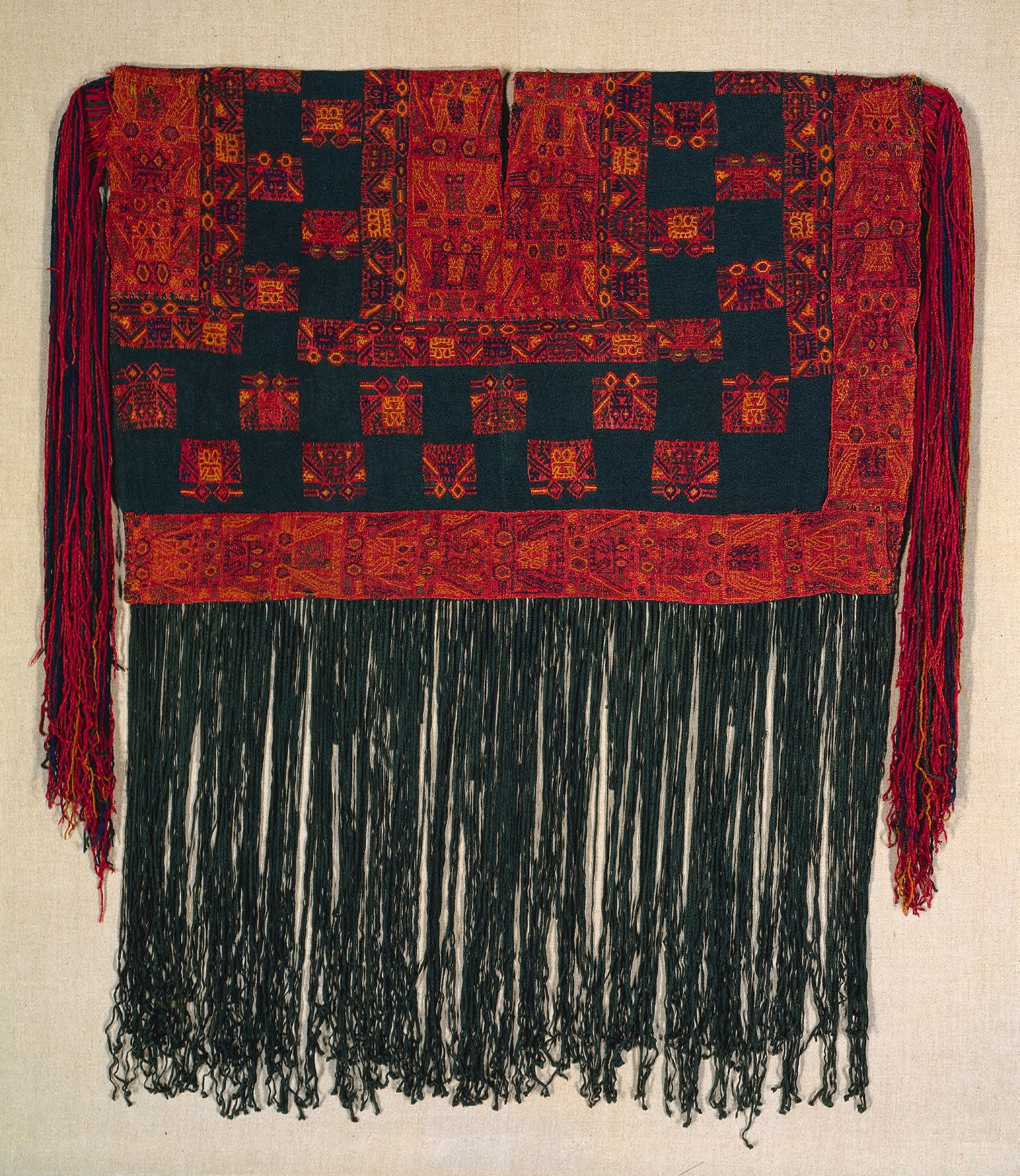The Cleveland Museum of Art
Collection Online as of April 19, 2024

Tunic
c. 300 BCE–200 CE
(Cavernas) style (700 BCE–1 CE)
Overall: 94 x 83.8 cm (37 x 33 in.); Mounted: 111.8 x 101.6 cm (44 x 40 in.)
The Norweb Collection 1946.227
Location: not on view
Did You Know?
Fine textiles were one of the most prestigious commodities in the ancient Andes.Description
The brightly dyed wool yarns found in many ancient Peruvian textiles come mainly from alpacas, camelids domesticated and selectively bred to produce long, soft, lustrous fiber. (Llamas are used mainly as pack animals, and slaughtered for meat). The Paracas people from the arid Peruvian coast probably obtained their wool from the highland region to the east, where camelids thrive. The versatility of Paracas textile-makers is demonstrated by the use of two distinct techniques to create the shirt's ornamentation. Around the neck and in the blue field the double-bird motifs are executed in embroidery, but the border strips are carried out in warp-faced plain weave, with multicolored warps substituted into place to create the pattern.- ?-1946Emery May Holden Norweb [1895-1984] and Raymond Henry Norweb [1894-1983], Cleveland OH, 1946, given to the Cleveland Museum of Art1946The Cleveland Museum of Art
- The Cleveland Museum of Art. The Cleveland Museum of Art Handbook. Cleveland, OH: The Cleveland Museum of Art, 1958. Mentioned and Reproduced: cat. no. 341 archive.orgThe Cleveland Museum of Art. Handbook of the Cleveland Museum of Art/1966. Cleveland, OH: The Cleveland Museum of Art, 1966. Reproduced: p. 297 archive.orgThe Cleveland Museum of Art. Handbook of the Cleveland Museum of Art/1969. Cleveland, OH: The Cleveland Museum of Art, 1969. Reproduced: p. 297 archive.orgThe Cleveland Museum of Art. Handbook of the Cleveland Museum of Art/1978. Cleveland, OH: The Cleveland Museum of Art, 1978. Reproduced: p. 401 archive.orgThe Cleveland Museum of Art. Handbook of the Cleveland Museum of Art. Cleveland, OH: The Cleveland Museum of Art, 1991. Reproduced: p. 8 archive.orgCleveland Museum of Art. The CMA Companion: A Guide to the Cleveland Museum of Art. Cleveland: Cleveland Museum of Art, 2014. Mentioned and reproduced: P. 332; Reproduced: P. 320-321Cleveland Museum of Art. Museum Masters: 2016-17 Companion Guide. [Cleveland, Ohio]: Cleveland Museum of Art, 2016. Mentioned and Reproduced: P. 28
- Gallery 232-Andean Textile Rotation. The Cleveland Museum of Art, Cleveland, OH (organizer) (August 28, 2019-November 9, 2020).Gallery 232- Andean Textile Rotation. The Cleveland Museum of Art, Cleveland, OH (organizer) (March 20, 2013-August 25, 2014).The Andean Tunic: 200 BCE - 1650 CE. The Metropolitan Museum of Art, New York, NY (organizer) (March 8-October 16, 2011).Treasures of Peruvian Gold. The Cleveland Museum of Art, Cleveland, OH (February 23-April 3, 1966).Treasures of Peruvian Gold. The Cleveland Museum of Art, Cleveland, OH (February 23-April 3, 1966).Ancient Arts of the Andes. The Museum of Modern Art, New York, NY (January 26, 1954-March 26, 1954).Art of the Americas. The Cleveland Museum of Art, Cleveland, OH (organizer) (November 9, 1945-January 6, 1946).Ancient Peruvian Textiles. The Cleveland Museum of Art, Cleveland, OH (March 5, 1941-April 6, 1941).
- {{cite web|title=Tunic|url=false|author=|year=c. 300 BCE–200 CE|access-date=19 April 2024|publisher=Cleveland Museum of Art}}
Source URL:
https://www.clevelandart.org/art/1946.227